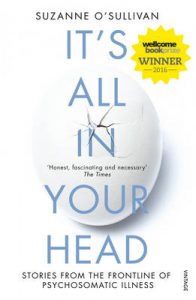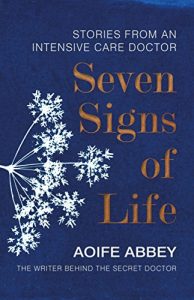 Aoife Abbey is an ‘intensivist’. At one level this means a doctor in intensive care, responsible for patients in extremis, often sedated and ventilated, and sometimes never conscious of the people caring for them. So it might seem strange that Abbey focuses her memoir not on the bodily functions that are essential for life – provided by heart, lungs, kidneys and so on – but on emotions and sensory perception: fear, grief, joy, distraction, anger, disgust, hope. But on another level this is natural, for she is a doctor who feels things intensely, and thinks profoundly about her interactions … Read more...
Aoife Abbey is an ‘intensivist’. At one level this means a doctor in intensive care, responsible for patients in extremis, often sedated and ventilated, and sometimes never conscious of the people caring for them. So it might seem strange that Abbey focuses her memoir not on the bodily functions that are essential for life – provided by heart, lungs, kidneys and so on – but on emotions and sensory perception: fear, grief, joy, distraction, anger, disgust, hope. But on another level this is natural, for she is a doctor who feels things intensely, and thinks profoundly about her interactions … Read more...
Category: Clinician Accounts
Arthur Kleinman – The Illness Narratives
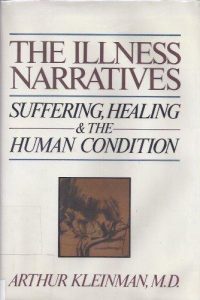 Like Susan Sontag, Arthur Kleinman was concerned with the meanings of illness, what cultural values bring to the interpretation of symptoms, or an illness, and how illness is managed within a life. They were both writing in the 1980s, observing the ways in which medicine was failing in some aspects of its fundamental caring role. Patients were treated for their diseases, but they were not always heard for how their illnesses affected, and emerged from, their life story. Sontag used the essay format to express her observations that sickness is much more than the biophysical entity that is a … Read more...
Like Susan Sontag, Arthur Kleinman was concerned with the meanings of illness, what cultural values bring to the interpretation of symptoms, or an illness, and how illness is managed within a life. They were both writing in the 1980s, observing the ways in which medicine was failing in some aspects of its fundamental caring role. Patients were treated for their diseases, but they were not always heard for how their illnesses affected, and emerged from, their life story. Sontag used the essay format to express her observations that sickness is much more than the biophysical entity that is a … Read more...
Kathryn Mannix – With The End In Mind
 It has nothing new to observe that in western society death and old age have been cleaned out of everyday view. Palliative care consultant Kathryn Mannix has seen enough death and dying to know that this is not a subject to shy away from. We will all face it at some point. She is doing her bit to help us prepare for dying, since the old acquaintance with death has disappeared. She does this with a series of fictionalised encounters with individuals and carers (and clinicians) she has met during her career, from when she was a medical student, through … Read more...
It has nothing new to observe that in western society death and old age have been cleaned out of everyday view. Palliative care consultant Kathryn Mannix has seen enough death and dying to know that this is not a subject to shy away from. We will all face it at some point. She is doing her bit to help us prepare for dying, since the old acquaintance with death has disappeared. She does this with a series of fictionalised encounters with individuals and carers (and clinicians) she has met during her career, from when she was a medical student, through … Read more...
Abraham Verghese – Soundings
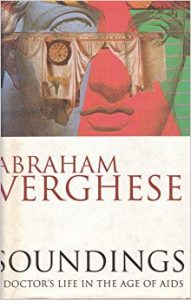 Clinical work often involves intense interactions with patients and their carers, and sometimes this can be very draining. Coming to terms with the nature of care, and negotiating the balance between the demands of home and a clinical calling is a complex process which is not easily described. In every situation, and for every individual, there will be different choices and accommodations. Abraham Verghese gave an unforgettable account of his struggles with these choices in Soundings, his first book, published in 1994.
Clinical work often involves intense interactions with patients and their carers, and sometimes this can be very draining. Coming to terms with the nature of care, and negotiating the balance between the demands of home and a clinical calling is a complex process which is not easily described. In every situation, and for every individual, there will be different choices and accommodations. Abraham Verghese gave an unforgettable account of his struggles with these choices in Soundings, his first book, published in 1994.
In America Soundings was published as My Own Country, but a more direct description of its … Read more...
John Launer – How Not to be a Doctor
 John Launer is a GP and medical educator. The fifty entertaining and stimulating essays collected in How Not to be a Doctor were all first published in the Postgraduate Medical Journal and the Quarterly Journal of Medicine. They are well worth dipping into.
John Launer is a GP and medical educator. The fifty entertaining and stimulating essays collected in How Not to be a Doctor were all first published in the Postgraduate Medical Journal and the Quarterly Journal of Medicine. They are well worth dipping into.
Launer is a passionate advocate of the importance of patient stories. This means not just careful listening and interpretation of stories for clinical and diagnostic purposes, but also enabling patients to construct stories to make sense of their lives.
There are several essays about important questions for doctors to ask in the consultation process. He gives … Read more...
Oliver Sacks – Awakenings
 This is an early classic of the ‘illness narrative’ literature, albeit one written by a clinician. Twenty detailed case studies form the central section of this book, describing the use in the late 1960s of a new miracle drug for people with post-encephalitic Parkinsonism. But these are not dry clinical case studies in which signs and symptoms are listed and described, and then synthesised to form predicted rules of human response to a drug. Instead, the case studies are rich descriptions of historical people, whose words, individuality and priorities colour the pages. Sacks paints the manifold presentations of the ‘sleepy … Read more...
This is an early classic of the ‘illness narrative’ literature, albeit one written by a clinician. Twenty detailed case studies form the central section of this book, describing the use in the late 1960s of a new miracle drug for people with post-encephalitic Parkinsonism. But these are not dry clinical case studies in which signs and symptoms are listed and described, and then synthesised to form predicted rules of human response to a drug. Instead, the case studies are rich descriptions of historical people, whose words, individuality and priorities colour the pages. Sacks paints the manifold presentations of the ‘sleepy … Read more...
Tanya Byron – The Skeleton Cupboard
 Tanya Byron is now a well-known media personality, a journalist, a campaigner for children’s mental health, and a public communicator of science. But she trained as a clinical psychologist. This book is a fascinating, riveting and also humorous account of her first year of clinical training.
Tanya Byron is now a well-known media personality, a journalist, a campaigner for children’s mental health, and a public communicator of science. But she trained as a clinical psychologist. This book is a fascinating, riveting and also humorous account of her first year of clinical training.
The people portrayed in The Skeleton Cupboard are apparently fictional, made up from the many clients and colleagues that Tanya Byron has known. This is inevitable given the professional requirements of confidentiality and anonymity. But it raises questions about the authenticity of the overall account.
That said, the book is very believable, although Tanya’s … Read more...
Oliver Sacks – The Man Who Mistook His Wife For A Hat
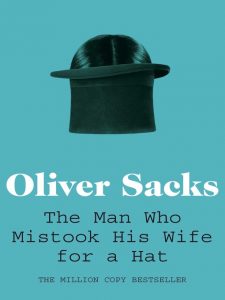 Oliver Sacks differentiates his vignettes from conventional medical case histories by their engagement with ‘the person, and the experience of the person, as he faces, and struggles to survive, his disease’. This collection of portraits is therefore included in these ‘illness narratives’ for their insights into the personal experience of different conditions. It is for the reader to judge how well Sacks fulfils his undertaking to engage with the individual and enter his experience. When I read these today, I am very aware of Sacks the neurologist, determined to classify exactly, using exactly the correct medical terminology. But perhaps his … Read more...
Oliver Sacks differentiates his vignettes from conventional medical case histories by their engagement with ‘the person, and the experience of the person, as he faces, and struggles to survive, his disease’. This collection of portraits is therefore included in these ‘illness narratives’ for their insights into the personal experience of different conditions. It is for the reader to judge how well Sacks fulfils his undertaking to engage with the individual and enter his experience. When I read these today, I am very aware of Sacks the neurologist, determined to classify exactly, using exactly the correct medical terminology. But perhaps his … Read more...
Adrian Owen – How science found a way to help coma patients communicate
 This article (or podcast) refers to one particular patient encountered by Adrian Owen in his investigations with people in coma. It is a short and very moving account of how clinicians used fMRI to enable a 38 year-old man in deep coma to communicate with the people caring for him. By imagining how to play tennis at particular moments Scott Routley was able to signal (either yes or no according to how the question was framed) by firing up his prefrontal cortex on the fMRI image, even though to neutral observers he seemed to be still deep in his … Read more...
This article (or podcast) refers to one particular patient encountered by Adrian Owen in his investigations with people in coma. It is a short and very moving account of how clinicians used fMRI to enable a 38 year-old man in deep coma to communicate with the people caring for him. By imagining how to play tennis at particular moments Scott Routley was able to signal (either yes or no according to how the question was framed) by firing up his prefrontal cortex on the fMRI image, even though to neutral observers he seemed to be still deep in his … Read more...
Suzanne O’Sullivan – It’s All In Your Head
Suzanne O’Sullivan is neurologist who has a particular interest in epilepsy. As a result she encounters people who have ‘dissociative seizures’ – fits which are not accompanied by the usual abnormal brain wave activity. These ‘pseudo’ seizures – the term has now been superceded – form the entry point for the world of ‘psychosomatic’ illness and ‘psychogenic’ conditions.
Anyone who works as a clinician will meet people who have symptoms that are unexplained by their diagnosis, or not consonant with neuroanatomy, or whose severity seems out of proportion with the pathology causing them. Indeed, anyone working as a clinician for … Read more...
